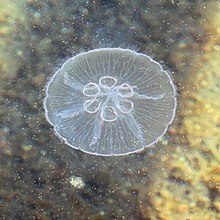Aurelia aurita
| Aurelia aurita | |
|---|---|

| |
| Aurelia aurita, Red Sea | |
| Scientific classification | |
| Domain: | Eukaryota |
| Kingdom: | Animalia |
| Phylum: | Cnidaria |
| Class: | Scyphozoa |
| Order: | Semaeostomeae |
| Family: | Ulmaridae |
| Genus: | Aurelia |
| Species: | A. aurita
|
| Binomial name | |
| Aurelia aurita | |
| Synonyms[1] | |
| |
Aurelia aurita (also called the common jellyfish, moon jellyfish, moon jelly or saucer jelly) is a species of the family Ulmaridae.[1][2] All species in the genus are very similar, and it is difficult to identify Aurelia medusae without genetic sampling;[3] most of what follows applies equally to all species of the genus.
The
The moon jelly differs from many jellyfish in that they lack long, potent stinging tentacles. Instead they have hundreds of short, fine tentacles that line the bell margin. The sting has no effect on humans.
Distribution
The species Aurelia aurita is found in the North, Black, Baltic and Caspian Seas, Northeast Atlantic, Greenland, northeastern USA and Canada, Northwest Pacific and South America.[3][4][5] In general, Aurelia is an inshore genus that can be found in estuaries and harbors.[6]
Aurelia aurita lives in ocean water temperatures ranging from 6–31 °C (43–88 °F); with optimum temperatures of 9–19 °C (48–66 °F). It prefers temperate seas with consistent currents. It has been found in waters with salinity as low as 6 parts per thousand.[7] The relation between summer
Feeding
Aurelia aurita and other Aurelia species feed on plankton that includes organisms such as mollusks, crustaceans,
The food is caught with its nematocyst-laden tentacles, tied with mucus, brought to the
Body system

Aurelia does not have
The basic body plan of Aurelia consists of several parts. The animal lacks respiratory,
The medusae are either male or female.
A recent study has found that A. aurita are capable of life cycle reversal where individuals grow younger instead of older, akin to the "immortal jellyfish" Turritopsis dohrnii.[15]
There has been a study presenting that Aurelia's body system is not significantly affected by artificial materials like microbeads, which can be found in cosmetic and personal care products. Aurelia aurita was able to recognize that microbeads were not food so there was not any physiological or histological harm.[16]
Predators

Aurelia aurita have high proportions of
Aurelia jellyfish naturally die after living and reproducing for several months. It is probably rare for these moon jellies to live more than about six months in the wild, although specimens cared for in public aquarium exhibits typically live several to many years. In the wild, the warm water at the end of summer combines with exhaustive daily reproduction and lower natural levels of food for tissue repair, leaving these jellyfish more susceptible to bacterial and other disease problems that likely lead to the demise of most individuals. Such problems are responsible for the demise of many smaller species of jellyfish.[21] In 1997, Arai summarized that seasonal reproduction leaves the gonads open to infection and degradation.[10]
Some
Gallery
-
Aurelia aurita in the Pairi Daiza aquarium, Belgium
-
Aurelia sp. from the Monterey Bay Aquarium
-
A damaged Aurelia sp. individual
-
An adult Aurelia aurita
-
On the beach
-
Aurelia aurita washed up on the beach, Jūrmala
References
- ^ a b "Aurelia aurita (Linnaeus, 1758)". WoRMS. World Register of Marine Species. 2023. Retrieved 29 August 2023.
- ^ Dawson, Michael N. "Aurelia species". Archived from the original on 2018-03-25. Retrieved 2008-08-12.
- ^ PMID 34589293.
- PMID 16103373.
- S2CID 189820003.
- ^ a b c d e f Russell, F. S. (1953). The Medusae of the British Isles II. London: Cambridge University Press. pp. 81–186. Archived from the original on 2016-06-23. Retrieved 2012-07-03.
- ^ a b Rodriguez, R. J. (February 1996). "Aurelia aurita (Saucer Jelly, Moon Jelly, Common Sea Jelly Jellyfish) Narrative".
- ^ S2CID 83862921.
- ^ Uye, S.; Fujii, N.; Takeoka, H. (2003). "Unusual aggregations of the scyphomedusa Aurelia aurita in coastal waters along western Shikoku, Japan" (PDF). Plankton Biology and Ecology. 50 (1): 17–21.
- ^ ISBN 978-0-412-45110-2.
- ^ Rees, W. J. (1966). The Cnidaria and Their Evolution. London: Academic Press. pp. 77–104.
- ISBN 978-0-534-39175-1.
- ^ Tree of Life – NJ Jellyfish – Aurelia aurita
- ISBN 978-0-07-229641-9.
- PMID 26690755.
- S2CID 218504266.
- ^ "Jellyfish contain no calories, so why do they still attract predators?". ScienceDaily. Retrieved 2020-06-29.
- S2CID 84652019.
- .
- S2CID 24694789.
- ^ Mills, C. E. (1993). "Natural mortality in NE Pacific coastal hydromedusae: grazing predation, wound healing and senescence". Bulletin of Marine Science. 53 (Proceedings of the Zooplankton Ecology Symposium): 194–203.
- Suzuki, Kentaro S.; Kumakura, Emi; Nogata, Yasuyuki (2016). "Incidental consumption of ephyrae of moon jellyfish Aurelia aurita s.l. by three filter-feeding sessile organisms: laboratory experiments". Fisheries Science. 82 (6): 923–930. .
Further reading
- Moen, F.E.; E. Svensen (2004). Marine fish & invertebrates of Northern Europe. ISBN 978-0-9544060-2-8.
External links
 Media related to Aurelia aurita at Wikimedia Commons
Media related to Aurelia aurita at Wikimedia Commons- Photos of Aurelia aurita on Sealife Collection







